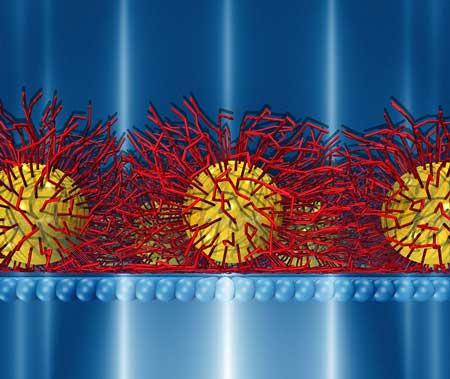| Posted: Apr 14, 2016 |
Janus-like nanoparticle membranes
(Nanowerk News) Nanoparticles are known to self-assemble at the air-water interface into large two-dimensional (2D) sheets. Researchers at Argonne National Laboratory, the University of Chicago and the University of Missouri recently discovered that an organic coating on the nanoparticles differs slightly between the two sides of the membrane. There is a tiny sub-nanometer molecular thickness difference that can guide the folding of the sheets into more complex 3D structures ("Subnanometre ligand-shell asymmetry leads to Janus-like nanoparticle membranes").
|
 |
| MD simulation shows membranes with an asymmetric molecular distribution of about 0.6 nm; yellow = gold; red = organo-thiol ligand molecules. Background: simulated grazing incidence small angle synchrotron x-ray scattering pattern that is used to compare with experimental measurements.
|
|
Understanding the molecular origin of the Janus-like nanoparticle membrane behavior offers new design principles for creating complex artificial superstructures through nanoparticle self-assembly, with opportunities for tuning their electrical, magnetic, and mechanical properties for targeted applications in areas such as molecular separations and chemical sensing.
|
|
Membranes made from nanoparticles offer versatility because both the inorganic core and the organic ligand shell composition can be tuned independently.
|
|
Recent studies reveal a specific and surprising physical property of these membranes. Because nanoparticle membranes are formed at an air-water interface, the organic shell molecules on the nanoparticle surface can develop an asymmetric distribution. Qualitative evidence that this asymmetry exists comes from two experimental observations. When the membranes detach from the edge, they tend to roll into tubes upon exposure to electron beams, but always towards the water-facing side of the membrane.
|
|
Furthermore, surface-enhanced Raman scattering measurements have dramatically different values between the two sides of the membrane. Quantitative measurements of the molecular asymmetry were carried out using grazing incidence small angle synchrotron x-ray scattering. These measurements show a molecular thickness difference of just 6 Å between the two sides of the membrane.
|
|
Theoretical molecular dynamics simulations further elucidate the role and interplay of the organic ligand coverage and mobility in producing and maintaining this asymmetry.
|
|
Understanding this Janus-like membrane based solely on ligand distribution asymmetry opens up new avenues for designing nanoparticle superstructures.
|

